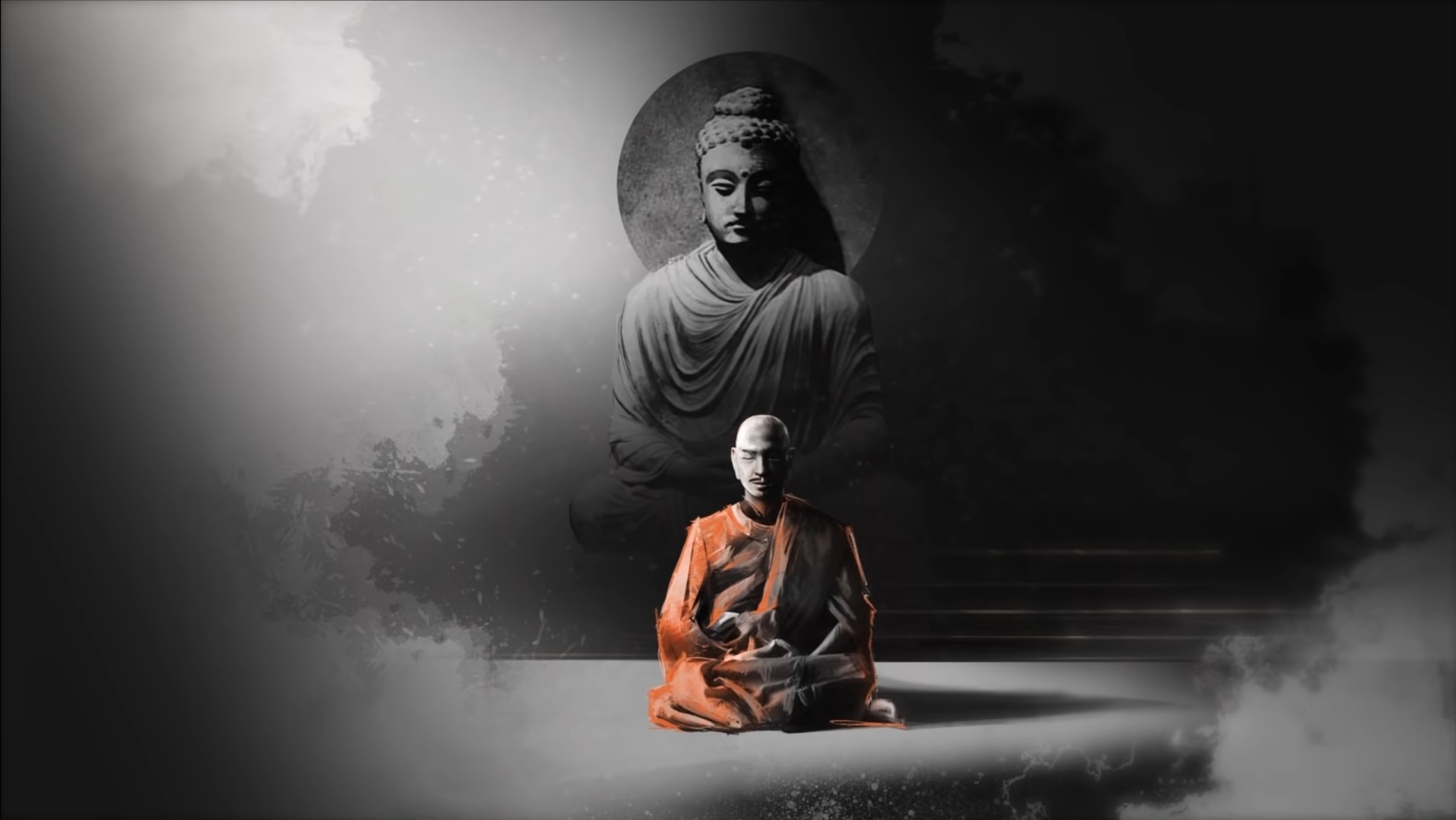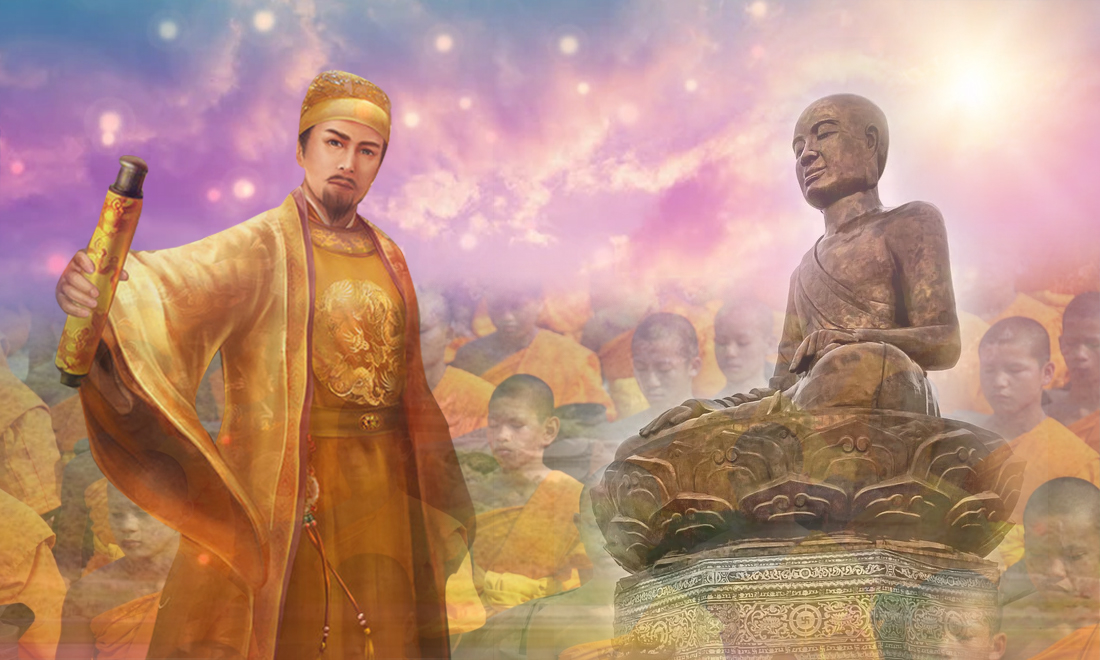King Tran Nhan Tong, born Tran Kham on December 7, 1258 (11th day of the 11th lunar month in the year Mau Ngo), was the eldest son of King Tran Thanh Tong and Empress Nguyen Thanh. His physique bore unusual characteristics, notably a golden complexion, which earned him the epithet "Golden Buddha" bestowed by his royal father.

Growing up, at the age of 16 (1274), he was appointed as the Crown Prince of the Eastern Palace and that same year, he was betrothed to Princess Thanh Quyên, the eldest daughter of Grand Prince Hưng Đạo. King Tran Thanh Tong invited Confucian scholars, experts in the Four Books and Five Classics, to educate him, including Le Phu Tran, Nguyen Thanh Huan, Nguyen Si Co, and others, all of whom devotedly imparted their teachings. The King also prepared the Di hau luc (Imperial Edict of Heir Education) to instruct the Crown Prince in statecraft, preparing him for future responsibilities.
In Buddhist teachings, he studied under Tue Trung Thuong Si, who wholeheartedly guided him and exchanged insights into Zen Buddhism. His favorite teaching was: "Reflecting on oneself is the essence of duty; not submitting to others' wishes brings true accomplishment." He revered Tue Trung Thuong Si as his Master. He frequently visited Tu Phuc Pagoda in the capital to chant sutras, practice meditation, and pay homage to the Triple Gem.

At the age of 21 (1279), Tran Nhan Tong ascended the throne under the reign title Thieu Bao, succeeding his father Tran Thanh Tong, to govern Dai Viet with benevolent rule, ensuring the people's livelihoods and well-being.
Amid the threat of foreign invasion by the Yuan-Mongol forces advancing towards the southern lands, in 1282, he presided over the Binh Than Conference to gather the opinions of the populace for a monumental national defense effort. In 1284, prior to the impending conflict, he chaired the Dien Hong Conference, seeking counsel from tribal elders and leaders, where all present, young and old, men and women alike, unanimously rallied for decisive action.
In 1285, driven by a patriotic spirit and determination to defend the nation, Tran Nhan Tong lead Dai Viet to victory in the first Yuan-Mongol invasion.
Faced with further Yuan-Mongol ambitions to conquer Chiem Thanh (modern-day Hanoi) and expand their influence southward, Tran Nhan Tong once again led a valiant defense in 1288, achieving victory for the second time. Inspired by the triumph of the nation, he composed two enduring verses:
"Xã tắc hai phen chồn ngựa đá
Non sông muôn thuở vững âu vàng"
After securing peace and stability for the people, Tran Nhan Tong consolidated the imperial court, fostered unity among the populace, and oversaw the reconstruction and development of the country in the post-war era. Pursuing reconciliation, he forgave past mistakes of court officials and nobles.
At the age of 41 (1293), he abdicated the throne to his son Tran Nhan Tong, assuming the title Thai Thuong Hoang.
In 1294, he led a military campaign to pacify Champa (Ai Lao), securing the nation's borders and ensuring continued vassalage from Champa to Dai Viet.
Returning to Vu Lam Palace in Ninh Binh, Tran Nhan Tong sought spiritual guidance, requesting the venerable master Hue Tue to officiate his monastic ordination and engage in meditation practice.
In 1299, resolved to make a final pilgrimage, he traveled to visit his spiritual teacher one last time, then ascended Mount Yen Tu in Quang Ninh province to dedicate himself to meditation and spiritual contemplation, assuming the name "Huong Van Dai Dau Da." He received the Dharma lineage from Dong Kien Cuong and was bestowed the Dharma name Phap Loa.

In 1301, Tran Nhan Tong embarked on a diplomatic mission to Chiem Thanh (Hanoi), fostering religious understanding and establishing cooperative and peaceful relations with neighboring states. Upon his return to Pho Minh Pagoda in Thien Truong, he delivered sermons, teachings, and hosted a grand Buddhist assembly for the people.
By 1304, Tran Nhan Tong traveled extensively throughout Dai Viet, encouraging adherence to the Five Precepts and promoting the Ten Virtues, urging the abandonment of unorthodox worship practices and superstitions. He established the Tri Kien Hermitage in Bo Chanh, Quang Binh, where he stayed for a period. Subsequently, upon the request of King Tran Anh Tong, he entered the royal palace to bestow the Bodhisattva precepts upon civil and military officials.
Following his diplomatic visit to Chiem Thanh in 1301, Tran Nhan Tong had promised the hand of Princess Huyen Tran to Che Man, the King of Champa. In 1305, King Chiem Thanh sent Che Bo Dai and a diplomatic mission bearing gifts of gold and silver to formalize the engagement. By 1306, Tran Nhan Tong officiated the marriage ceremony between Princess Huyen Tran and Che Man, solidifying an alliance that included the cession of Chau O and Chau Ri provinces to Dai Viet as part of the marriage agreement, facilitating Dai Viet's expansion southward into Thuan Hoa(Hue).
In 1307, Tran Nhan Tong transmitted the Eight Precepts to the monk Phap Loa, appointing him as the Second Patriarch of the Truc Lam Zen lineage. During this period, he frequently visited various Pagodas such as Bao An Sieu Loai, Sung Nghiem Hai Duong, Vinh Nghiem Lang Giang, Tu Lam, and Quynh Lam Dong Trieu to deliver teachings and oversee ceremonies.
After transmitting the Eight Precepts to Phap Loa, Tran Nhan Tong focused on compiling scriptures and historical records. His contributions include valuable literary works such as "Tran Nhan Tong Thi Tap" (Poetry Collection of Tran Nhan Tong), "Dai Huong Hai An Thi Tap" (Poetry Collection of Dai Huong Hai An), "Tang Gia Toai Su" (Biographies of Eminent Monks), "Thach That My Ngu" (Stone Abode Records), "Trung Hung Thuc Luc" (Records of the Prosperous and Flourishing Period), and "Truyen Dang Luc" (Records of Transmissions and Illuminations).

Tran Nhan Tong, devoted to protecting the land and its people, penned the verse "Phap Than Thuong Tru" (Dharma Body Stands Firm) in response to a question posed by his close attendant Bao Sat: "All phenomena are neither produced nor destroyed. Whoever understands this truth will see Buddhas manifest before them. Neither coming nor going" (Phap Than Thuong Tru, Nhat thiet phap bat sanh. Nhat thiet phap bat diet. Nhuoc nang nhu thi giai. Chu Phat thuong tai tien. Ha khu lai chi huu).
According to historical records, Tran Nhan Tong entered parinirvana on the 1st day of the 11th month in the year of Mau Than (1308), peacefully passing away at Am Ngoa Van in Dong Trieu, Quang Ninh, at the age of 51. King Tran Anh Tong respectfully transported his remains to the capital Thang Long for a national funeral, which lasted two weeks. Subsequently, domestic and foreign dignitaries, civil and military officials, disciples of Phap Loa, Bao Sat, and monks held the traditional tea-offering ceremony.
After collecting the relics, they were divided into two parts: one for constructing a stupa at Lang Quy Duc Palace in Long Hung, Thai Binh; the other for erecting a revered stupa at Van Yen Pagoda in Yen Tu, Quang Ninh, named Hue Quang Kim Thap, honoring the Supreme Saint Tran Trieu, Truc Lam First Patriarch (Truc Lam Dau Da), Tinh Tue Giac Hoang Dieu Ngu Phat To.
"Hail to Truc Lam First Patriarch, Supreme Teacher, Great Proof."
"Quote from the Vietnam Buddhist Sangha"